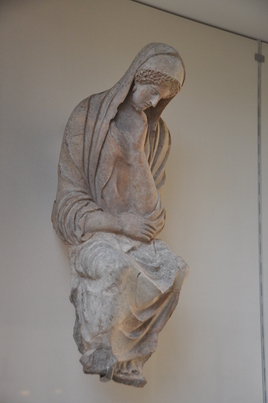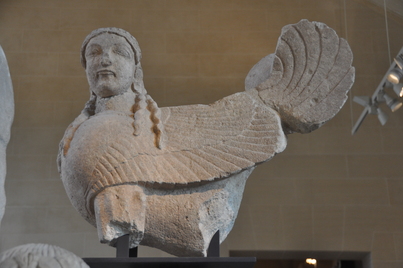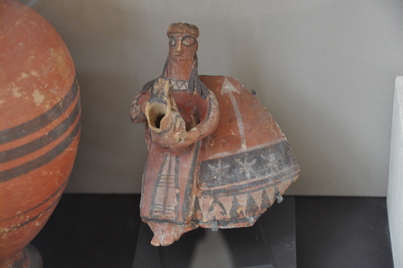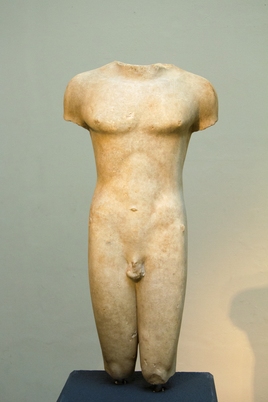Il n'y a pas une annotation en français. Présenté est une annotation en Anglais.
The site was occupied as early as 4000 B., but the earliest architectural remains recovered so far date to around 1000 BC. The archaic city was surrounded by a massive city wall. The city developed and grew wealthy from the nearby mining copper and gold in VII -IV centuries At the end of the sixth century town was damaged and abandoned. It was conquered by the Athenian general Kimon during his Cyprus campaign ca 450 BC. Later Marion was rebuilt in the beginning of the IIIrd century BC. after its total destruction by Ptolemy I Soter I also known as Ptolemy Lagides (c. 367 BC – 283/2 BC) in 312 BC and was re-named Arsinoe in honour of Arsinoe II, sister and wife of Ptolemy Philadelphos.
sources:
- Strabo
- Pliny the Elder
- http://www.mlahanas.de/Cyprus/Geo/MarionCyprus.html
- http://web.princeton.edu/sites/Archaeology/rp/polisexhibit/intro.html
- William P. Childs: The Iron Age kingdom of Marion. In: Bulletin of the American Schools of Oriental Research. Band 308, 1997, pp. 37–48.
- Nancy Serwint: The Terracotta statue from ancient Marion. In Acta Cypriotica. Band 3, 1992, pp. 382–426.
- Edward Lipiński: The Cypriot vassals of Esarhaddon. In: Mordechai Cogan, Israel Ephʻal (Hrsg.): Ah, Assyria: studies in Assyrian history and ancient Near Eastern historiography presented to Hayim Tadmor. Magnes Press, Hebrew University, Jerusalem 1991, (Scripta Hierosolymitana) pp. 58–64.
- Antoine Hermary, The pictorial art of Cyprus in the First Millennium BC - http://kyprioscharacter.eie.gr/en/scientific-texts/details/archaeology/pictorial-art-of-cyprus-in-first-millennium-bc
The site was occupied as early as 4000 B., but the earliest architectural remains recovered so far date to around 1000 BC. The archaic city was surrounded by a massive city wall. The city developed and grew wealthy from the nearby mining copper and gold in VII -IV centuries At the end of the sixth century town was damaged and abandoned. It was conquered by the Athenian general Kimon during his Cyprus campaign ca 450 BC. Later Marion was rebuilt in the beginning of the IIIrd century BC. after its total destruction by Ptolemy I Soter I also known as Ptolemy Lagides (c. 367 BC – 283/2 BC) in 312 BC and was re-named Arsinoe in honour of Arsinoe II, sister and wife of Ptolemy Philadelphos.
sources:
- Strabo
- Pliny the Elder
- http://www.mlahanas.de/Cyprus/Geo/MarionCyprus.html
- http://web.princeton.edu/sites/Archaeology/rp/polisexhibit/intro.html
- William P. Childs: The Iron Age kingdom of Marion. In: Bulletin of the American Schools of Oriental Research. Band 308, 1997, pp. 37–48.
- Nancy Serwint: The Terracotta statue from ancient Marion. In Acta Cypriotica. Band 3, 1992, pp. 382–426.
- Edward Lipiński: The Cypriot vassals of Esarhaddon. In: Mordechai Cogan, Israel Ephʻal (Hrsg.): Ah, Assyria: studies in Assyrian history and ancient Near Eastern historiography presented to Hayim Tadmor. Magnes Press, Hebrew University, Jerusalem 1991, (Scripta Hierosolymitana) pp. 58–64.
- Antoine Hermary, The pictorial art of Cyprus in the First Millennium BC - http://kyprioscharacter.eie.gr/en/scientific-texts/details/archaeology/pictorial-art-of-cyprus-in-first-millennium-bc













